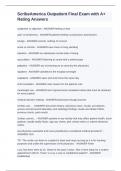Exam (elaborations)
ScribeAmerica Outpatient Final Exam with A+ Rating Answers
- Course
- Institution
subjective vs objective - ANSWER-feeling vs fact pain vs tenderness - ANSWER-patients feeling vs physicians assessment benign - ANSWER-normal, nothing of concern acute vs chronic - ANSWER-new onset vs long standing baseline - ANSWER-an individuals normal state of being ausculation - ...
[Show more]



